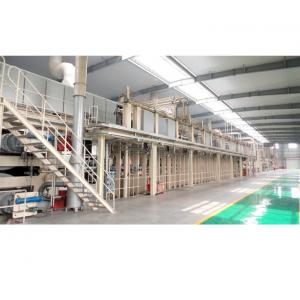

Add to Cart
Production Line Full Automatic Particle Board/MDF/OSB/Plywood Production Line
OSB Poduction Line | |
Raw material: | Logs, branches, twigs, industrial wood reidue |
Board size: | 3*6 feet, 4*8 feet, 6*9 feet, etc |
Annual capacity: | 10000cbm, 30000cbm, 50000cbm, 100000cbm |
Total power: | According to the capacity |
Control: | PLC |
Manufacture
Chip production
The trees are debarked after being cut. The bark can be sold for
use in landscaping, or burned in on-site furnaces. The debarked
logs are sent to the MDF plant, where they go through the chipping
process. A typical disk chipper contains 4–16 blades. Any resulting
chips that are too large may be re-chipped; undersized chips may be
used as fuel. The chips are then washed and checked for defects.
Chips may be stored in bulk, as a reserve for manufacturing.
Fibre production
Compared to other fibre boards, such as Masonite, MDF is
characterised by the next part of the process, and how the fibres
are processed as individual, but intact, fibres and vessels,
manufactured through a dry process. The chips are then compacted
into small plugs using a screw feeder, heated for 30–120 seconds to
soften the lignin in the wood, then fed into a defibrator. A
typical defibrator comprises two counter-rotating discs with
grooves in their faces. Chips are fed into the centre and are fed
outwards between the discs by centrifugal force. The decreasing
size of the grooves gradually separates the fibres, aided by the
softened lignin between them.
From the defibrator, the pulp enters a 'blowline', a distinctive
part of the MDF process. This is an expanding circular pipeline,
initially 40 mm in diameter, increasing to 1500 mm. Wax is injected
in the first stage, which coats the fibres and is distributed
evenly by the turbulent movement of the fibres. A urea-formaldehyde
resin is then injected as the main bonding agent. The wax improves
moisture resistance and the resin initially helps reduce clumping.
The material dries quickly in the final heated expansion chamber of
the blowline and expands into a fine, fluffy and lightweight fibre.
This fibre may be used immediately, or stored.
Sheet forming
Dry fibre gets sucked into the top of a 'pendistor', which evenly
distributes fibre into a uniform mat below it, usually of 230–610
mm thickness. The mat is pre-compressed and either sent straight to
a continuous hot press or cut into large sheets for a multi-opening
hot press. The hot press activates the bonding resin and sets the
strength and density profile. The pressing cycle operates in
stages, with the mat thickness being first compressed to around
1.5× the finished board thickness, then compressed further in
stages and held for a short period. This gives a board profile with
zones of increased density, thus mechanical strength, near the two
faces of the board and a less dense core.
After pressing, MDF is cooled in a star dryer or cooling carousel,
trimmed and sanded. In certain applications, boards are also
laminated for extra strength.
The environmental impact of MDF has greatly improved over the
years. Today, many MDF boards are made from a variety of materials.
These include other woods, scrap, recycled paper, bamboo, carbon
fibres and polymers, forest thinnings and sawmill off-cuts.
As manufacturers are being pressured to come up with greener
products, they have started testing and using non-toxic binders.
New raw materials are being introduced. Straw and bamboo are
becoming popular fibres because they are a fast-growing renewable
resource.
| Machine name | Item no | Unit | Q'ty | Power | Remark | |||
| A | Chip preparation section | |||||||
| A1 | Belt conveyor | Unit | 2 | |||||
| A2 | Drum chipper | BX218D | Unit | 2 | ||||
| A3 | Discharger | Design as requirement | Unit | 2 | ||||
| A4 | Belt conveyor | Design as requirement | Unit | 2 | ||||
| A5 | Belt conveyor | Design as requirement | Unit | 1 | ||||
| A6 | Bucket lifter | Design as requirement | Unit | 1 | ||||
| A7 | Belt conveyor | Design as requirement | Unit | 1 | ||||
| A8 | Magnetic metal remover | Unit | 2 | |||||
| B | Fiber preparation section | |||||||
| B1 | Wood chip Silo | Unit | 1 | |||||
| B2 | Infeed bucket | Unit | 1 | |||||
| B3 | Refiner | Unit | 1 | |||||
If you are interested, do not hesitate to contact me.
REGARDS!
